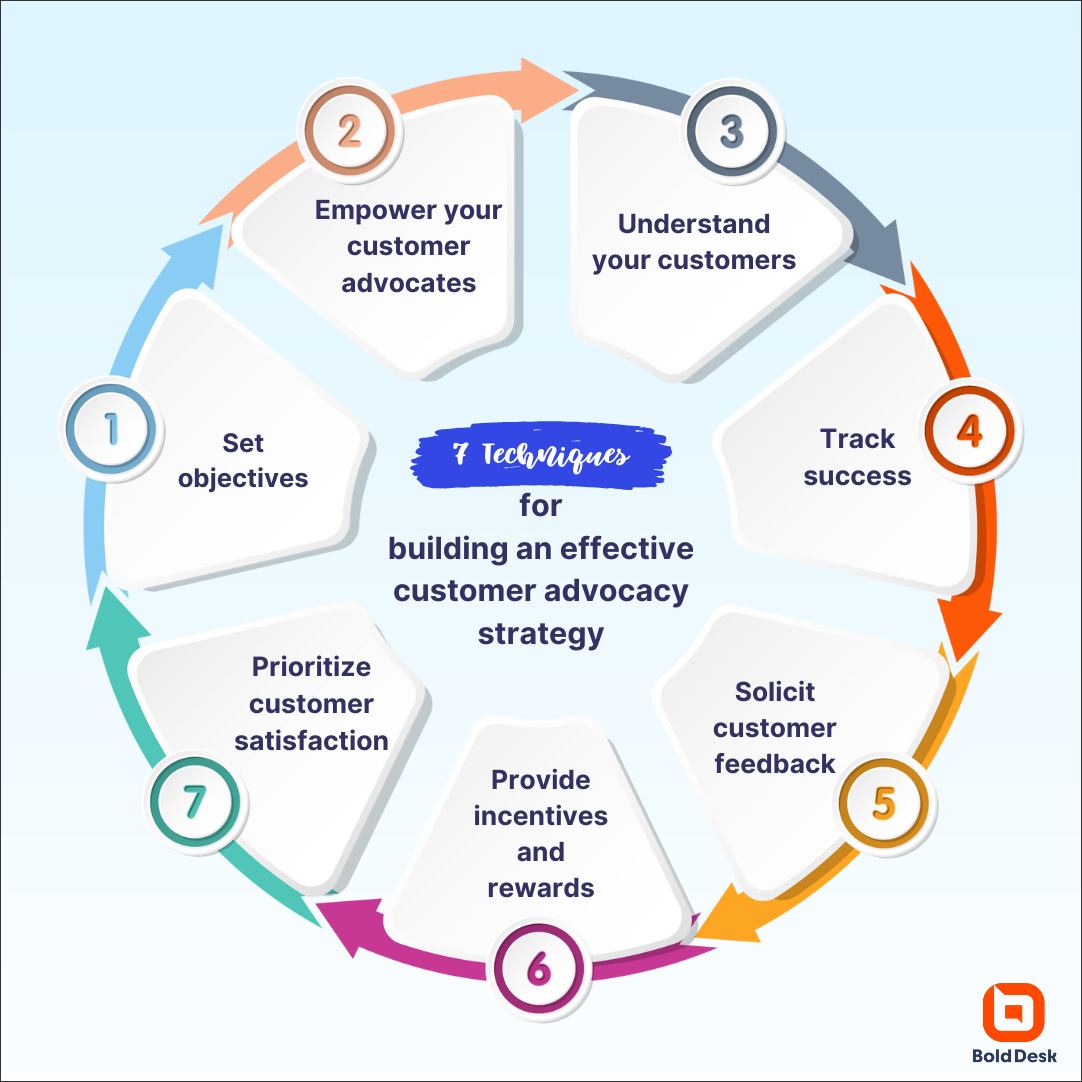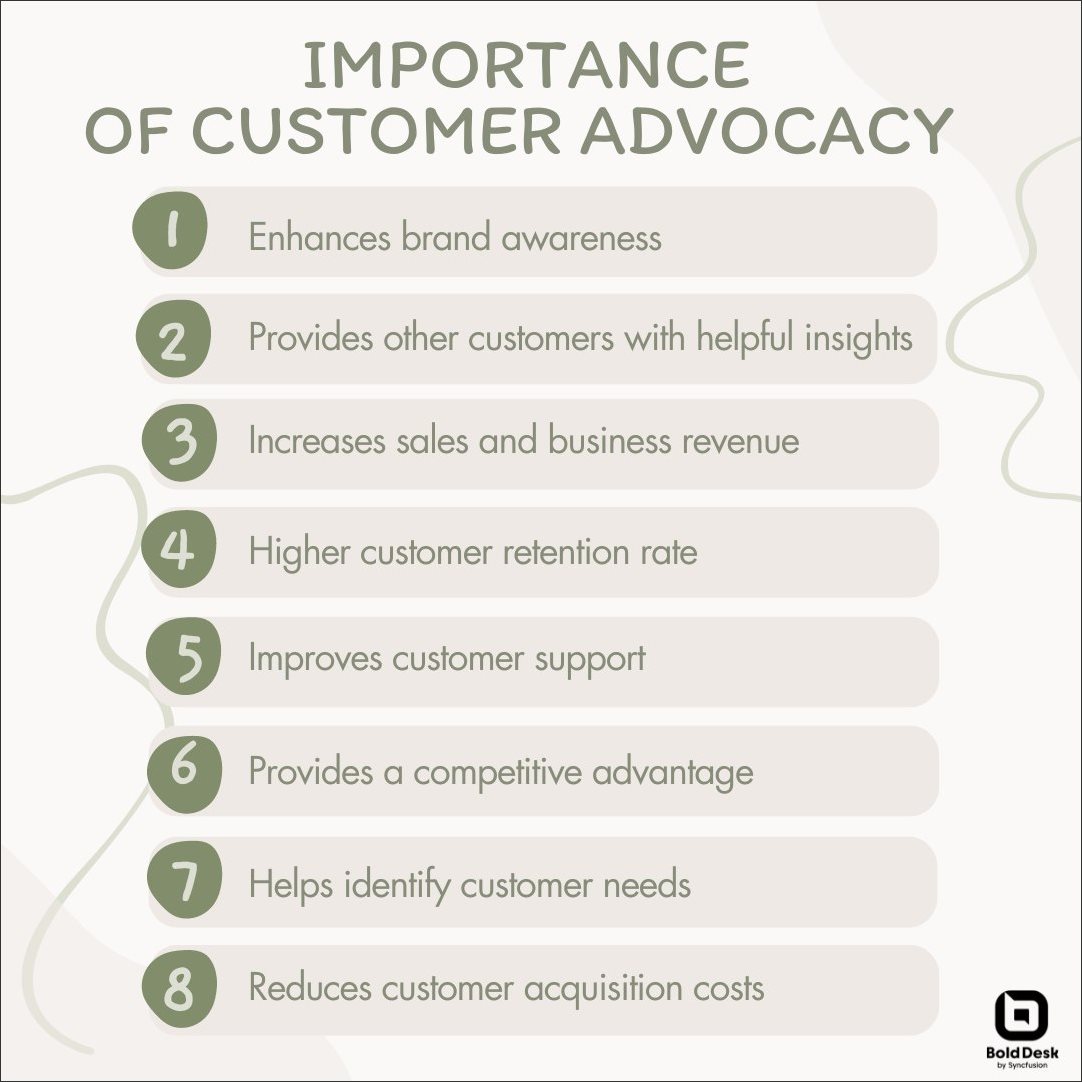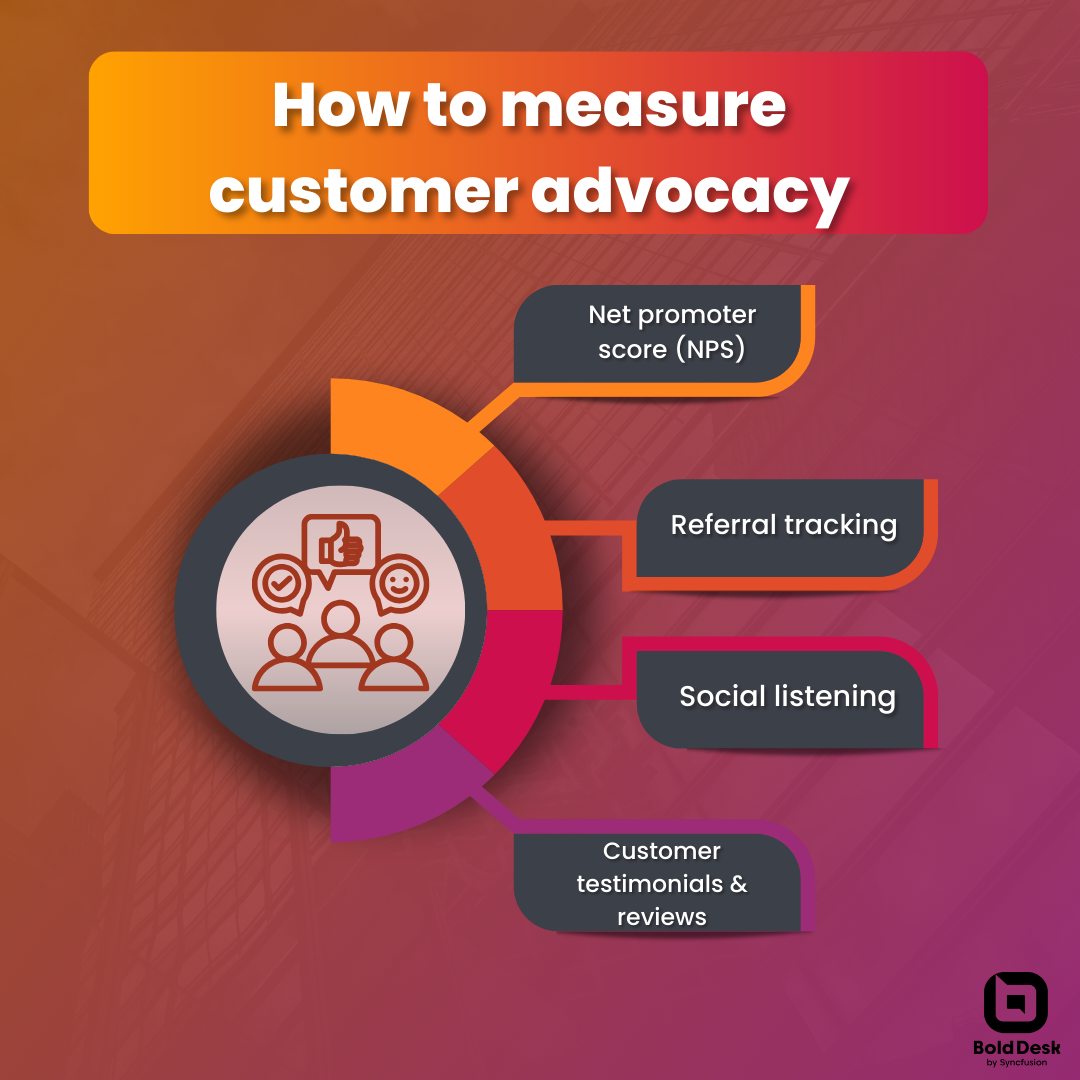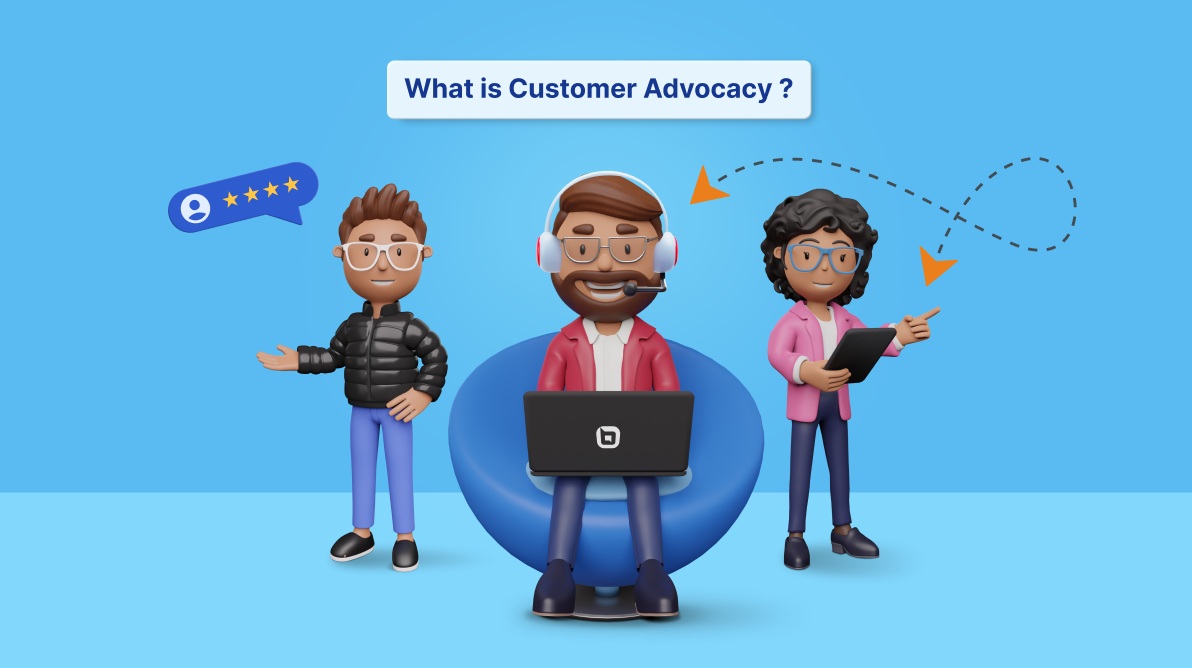Having happy and satisfied customers is vital to the success of businesses.
Going the extra mile to ensure you offer an outstanding customer experience is often rewarded by customer advocacy from regular customers who become loyal, vocal supporters of your business.
A survey conducted by Nielsen found that 92% of consumers rely on recommendations from friends and family more than any form of advertising when deciding to buy something.
This clearly demonstrates the power of having a robust network of loyal customers who can act as an extension of your customer service and sales teams, providing special perspectives and experiences that help both your business and other clients.
Adopting customer advocacy strategies is not only essential for gaining consumer trust, but also for enhancing brand reputation, increasing customer retention, and achieving higher revenues.
Now, the question arises: how can you improve customer advocacy? Don’t worry, we have a comprehensive guide for you in this article, covering various topics related to customer advocacy.
What is customer advocacy?
Customer advocacy is the process through which devoted and satisfied customers speak positively about and promote a company, product, or service.
This advocacy from loyal customers spreads through word-of-mouth and reviews and is likely to attract new customers to your business.
Whether they vigorously praise your goods and services or have had an exceptional experience with your customer service, customer advocacy encompasses all these experiences.
By offering more chances for your customers to promote and engage with your business positively, customer advocacy allows for the potential to achieve even greater levels of customer satisfaction.
What is a customer advocate?
A customer advocate is a highly satisfied and loyal customer who willingly and actively promotes and supports a company, its products, or its services because of their positive experiences.
These customer advocates usually use your product and features more effectively because they have better usage experiences and interactions with the products and services.
Therefore, they can easily assist other end users where necessary.
These individuals are more than ready to go the extra mile to serve as voluntary brand ambassadors.
The experiences of customer advocates are shared through:
- Word of mouth, where people share their experiences and recommendations verbally.
- Social media, where opinions and experiences are shared instantly with a large audience.
- Online reviews, where customers rate and give feedback about their experiences, and any other channels of communication where information and opinions are shared.
Additionally, businesses greatly benefit from customer advocates as they are instrumental in influencing brand reputation, credibility, and customer base through their recommendations and testimonials.
What is a customer advocacy program?
A customer advocacy program is a structured initiative implemented by a business to foster and cultivate a positive relationship with its customers.
The aim is to gain customer loyalty, trust, and active support through various strategies and activities that result in satisfied customers promoting the brand, products, or services.
Here are some common forms of customer advocacy programs:
- Referral programs.
- Testimonials and case studies.
- Online reviews and rating outreach.
- Social media advocacy outreach.
- Customer success stories.
Building an effective customer advocacy strategy
Companies can convert customers into brand ambassadors by following these methods.

1. Set an objective for your customer advocacy program
Establish your advocacy program’s goal, be it raising brand awareness, increasing revenue, or something else entirely.
- Ensure that your goals and vision can be results of your consumer advocacy strategy.
- Make sure everyone in the organization understands your customer advocacy vision and how it will benefit every side of the business.
- Outline the steps required to put strategic advocacy priorities into practice and lay out the ways success will be measured.
This thorough planning will make it possible to evaluate advocacy campaigns.
2. Empower your customer advocates’ voices
The core of any customer advocacy strategy is to empower customers’ voices.
This means giving customers the necessary resources and information to make informed assessments of your product and actively participate in shaping the brand’s image.
It is advantageous for every brand to assist in transforming their customers into industry influencers and brand evangelists.

Businesses can consider the following approaches:
- Give customers who have grown to trust and support the brand a platform to voice their opinions.
- Provide clients with video tutorials or manuals that they can share on their websites.
- Allow clients to share their insights and highlight them via webinars.
When your clients are willing to recommend your company, why not amplify their reach? Their friends and coworkers will read their endorsement and probably become curious to learn more about your offerings.
Through empowering their customers, brands can build a devoted following that not only supports the business but also acts as a catalyst for marketing its goods and services.
3. Understand your customers
Consider your customers’ goals and interests if you want to convert them into brand ambassadors.
Companies can demonstrate authentic concern for consumers’ requirements, preferences, and opinions by:
- Consistently interacting with them through various platforms.
- Instead of highlighting only the features of your product, highlight the value your goods and services bring to your clients.
- Assess the customer service and interactions provided by your team.
Additionally, your customer-facing teams can practice customer service empathy to ensure you understand customers’ feelings and emotions.
All things considered, turning regular consumers into advocates ultimately comes down to a customer-centric strategy in which you deliver top-notch customer support that yields customer loyalty and satisfaction.
4. Track success and promote stories of customer achievements
Businesses must assess different outcome measures to track their progress toward their customer advocacy goals. For example, they can track the following:
- Revenue.
- Win rate.
- Social media interactions.
- Net promoter score.
- Online reviews.
By tracking these metrics and comparing them before and after the implementation of the customer advocacy program, businesses can determine the program’s success.
Businesses can also generate and evaluate reports based on their customer advocacy program metrics to identify areas in need of further development.
Furthermore, by analyzing customer data, businesses can pinpoint customers who are most likely to become advocates and tailor their strategies to engage them effectively.

To demonstrate the value your product or services offer, focus on client success and testimonials on your website, social media accounts, and marketing collateral.
These stories showcase the positive outcomes and experiences that others have had, which can influence potential customers and strengthen your brand’s reputation.
True, relevant stories have the power to encourage other customers to become brand ambassadors.
5. Seek feedback to enhance support operations
The customer support team should communicate with customers frequently via a variety of platforms, including:
- Social media
- Live chat
- Community forums
- E-commerce websites
- Emails
- Online chats
Encouraging and responding to customer feedback can significantly improve customer advocacy by demonstrating that you value your customers’ opinions and are committed to addressing their needs and concerns.
Using surveys to collect precise data and feedback can help prevent customer sentiments from being misinterpreted.
Additionally, by using advocate feedback to enhance support training and quickly resolve customer concerns, support ticket traffic and response times can be decreased.
A very helpful, if seemingly outdated, way to better comprehend customer feedback is through a one-on-one phone conversation.
Customers appreciate talking to a real human being, and it shows them that your company cares about their business and feedback.
Be sure to address both positive and negative remarks to distinguish your brand from others.
6. Provide incentives and loyalty programs
Setting up loyalty programs and incentives is an effective strategy for improving customer advocacy.
It encourages customers to stay engaged with your brand, make repeat purchases, and actively promote your products or services.
Establish a loyalty program with:
- Rewards.
- Savings.
- First access to deals.
- Unique benefits.
Customers tend to spend a higher amount of money on brands to which they are loyal.
“43% of customers spend money on brands they’re loyal to.”- National Retail Federation
This is indicative of the fact that brand loyalty plays a crucial role in influencing the purchasing behavior of customers.
By offering referral prizes or discounts for successful referrals, brands can incentivize consumers to recommend their brand to others.
7. Prioritize customers’ satisfaction and enhance their experiences
Companies can foster a strong sense of loyalty and advocacy among their consumers by:
- Prioritizing customer satisfaction.
- Improving their overall experience.
- Rapidly and effectively addressing their requirements.
- Consistently exceeding their expectations.
Personalized interactions, proactive problem-solving, and a commitment to continuous improvement throughout the customer journey can help achieve this.
Ultimately, businesses that value and prioritize their customers can establish a stellar reputation and reap the benefits of positive word of mouth and the support of committed consumers.
The customer experience is improved when client suggestions are taken seriously and the best ones are implemented by the company.
Consequently, giving clients an excellent experience at every interaction and ensuring their satisfaction encourages them to become customer advocates and refer your business products or services to their colleagues and friends.
Why is customer advocacy important?
Implementing a fruitful customer advocacy approach is one of the most economical methods to expand your business.
Here are some of its significant advantages.

Enhances brand awareness
Customer advocates promote your product or service, share their experiences with it, empathize with other customers and customers of your competition, and provide valuable feedback in a manner that your sales team may not be able to do.
Customer advocates’ positive messages can reach many people, especially if they have a strong online presence or their brand validation goes viral.
Advocates spend more money with your business while being excellent influencers. They have the capability to boost brand awareness and are more likely to make regular purchases.
Provide insights and help to other customers
Advocates can support your team and help provide support to other customers in different ways, such as:
- Sharing their product knowledge with other users, particularly in customer self-service.
- Participate in community forums to address and answer questions
- Provide feedback on new updates, reducing the workload for support agents.
Advocates can also be identified with badges in online communities, making it easier for members to reach out to them if they have specific questions.
Since advocates are also your customers, they can provide valuable insights from the customer’s viewpoint.
As a perk, you can offer select customer advocates early access to upcoming releases and use their feedback to assist you in addressing problems before they are rolled out to a wider audience.
Increases sales and business revenue
Sales are significantly increased by customer advocacy. Customers who turn into advocates for your business are effectively unpaid brand ambassadors who spread the word about your goods and services.
Their word-of-mouth advertising, whether in person or online, attracts new customers and can significantly increase your sales, thus leading to higher revenue for your business.
Higher customer retention rate
Raising customer retention rates can be greatly aided by customer advocacy. Your consumers are more likely to stick with you if they see positive testimonials from fellow consumers.
Customer advocacy is a tried-and-true customer retention strategy because its core goal is to provide consumers with more reasons to be loyal to your company.
Customer retention and customer advocacy influence each other through the following:
- Retention campaigns.
- Listening and responding to customers.
- Customer success stories.
- Community building.
- Engagement and loyalty programs.
Improves customer support through self-service
Advocates are well-equipped to assist your customers due to their familiarity with your company and its products and services.
In the eyes of potential clients, your customer advocates can outperform your customer support team because of their practical experience with your product, making them relatable and trustworthy.
Advocates can also help customers through self-service channels like community forums.

A study by Harvard Business Review showed that 81% of customers, regardless of the type of business, try to resolve their problems on their own before contacting a live agent.
Therefore, if you have a centralized knowledge base software, advocates are likely to be active participants in it and can help others with customer onboarding or technical issues, reducing the need for your customer support team’s involvement.
Helps distinguish you from the competition
Implementing a customer advocacy strategy can help you capture previously untapped customers by using your existing customer base.
By prioritizing the needs and satisfaction of your customers, you establish a strong and loyal customer base that not only differentiates your brand but also fosters long-term success.
Therefore, if you’re looking for the most effective method to convince potential customers that you’re an exceptional business with an unbeatable range of services, customer advocacy from a vocal customer base is the way to do it.
Assists in proactively identifying and resolving customer needs
Within an organization, client advocacy is a major factor in speeding up the identification of consumer demands and addressing them accordingly.
By keeping tabs on what customer advocates are praising and criticizing about a company’s product, the company can better anticipate, identify, and address customer needs while staying ahead of its competitors.
Through a comprehensive understanding of their target market and expressed customer advocate wants, companies can proactively analyze trends, patterns, and behaviors.
This will help them predict the evolving needs and desires of their customers and tailor their product roadmaps accordingly.
Significantly reduces customer acquisition costs
Customer advocacy plays a significant role in reducing customer acquisition costs by leveraging the influence and recommendations of satisfied customers.
Customer advocates market your brand to others voluntarily, helping companies save on acquisition costs.
In conclusion, you can effectively turn these brand champions into an extension of your sales staff and build an organic pipeline for acquiring new customers by making customer advocacy a core component of your business strategy.
How to measure customer advocacy
Here are some key ways to measure the effectiveness of customer advocacy.

Net promoter score (NPS)
Net promoter score is a widely used metric for measuring customer loyalty and satisfaction. It is based on the likelihood of customers recommending a company or product to others.
It is measured by asking customers how likely they are to recommend a company/product/service to a friend or colleague on a scale from 0 to 10.
Respondents are then categorized into three groups:
- Promoters, who rated a 9 or 10.
- Passives, who rated a 7 or 8.
- Detractors, who rated 6 or lower.
By consistently monitoring and evaluating these metrics, you’ll be able to gauge the success of your customer advocacy efforts and better convert more customers into advocates.
Passives can be transformed into promoters through participation in incentive offers and referral programs.
The opinions of promoters can be reinforced by further encouraging their participation in these programs as well.
Referral tracking
Monitor the number of recommendations coming from your current clientele by tracking referrals back to the customers who first recommended your product to others.
You may need to use software designed specifically for tracking referrals to find out how many referrals you receive.
Social listening
Keep tabs on activity and interactions about your product on social media by searching for posts, likes, comments, and shares. Consider the following best practices:
- Especially seek those that pertain to customer recommendations of your company, positive advocacy, sentiment analysis, and trending issues.This can assist you in locating brand advocates and assessing the influence and scope of their advocacy.
- Check whether your business is getting attention on the channels you want to target, such as Facebook, X (formerly Twitter), or LinkedIn.
- How frequently does your business name appear in industry hashtags? Are you seeing discussion using your own hashtags for campaigns and events?
High engagement suggests that your customer advocates are connecting well with your target audience.
Customer testimonials and reviews
More client reviews, evaluations, and testimonials is a direct benefit of consumer advocacy.
In addition to the number of reviews, the rate at which new reviews or evaluations are accumulated is an indicator of how successful your customer advocacy strategy is.

Beyond the raw number of reviews, businesses can examine the sentiment of reviews and monitor trends or changes over time. This helps to evaluate what changes may need to be made to address evolving customer demands.
Make customer advocacy your best marketing strategy
Creating great client experiences builds a community of devoted brand advocates that helps spread the word about your brand and company.
Making customer advocacy a pillar of your marketing strategy will result in high-quality referrals from loyal, satisfied customers.
If you’re looking to enhance and capitalize on delivering outstanding customer service and client experiences, schedule a live demo to see how BoldDesk can be a key component of a successful customer advocacy program. Additionally, feel free to start a free trial to explore its many features.
If you have any questions about its capabilities, feel free to contact the BoldDesk support team.
Related articles


















 Email Ticketing System
Email Ticketing System Shared Inbox Software
Shared Inbox Software Multi Brand Help Desk
Multi Brand Help Desk Internal Help Desk Software
Internal Help Desk Software Trouble Ticketing Software
Trouble Ticketing Software Mobile Help Desk
Mobile Help Desk 

















